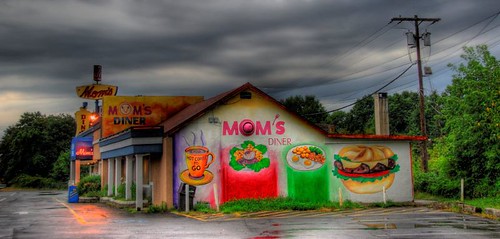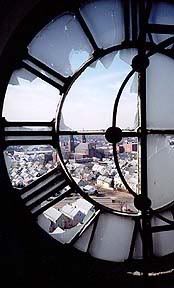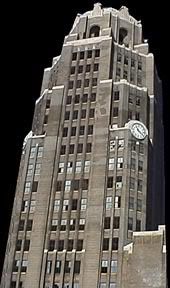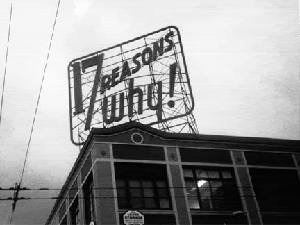
I remember this sign being part of my subconscious awareness while growing up in the city. I stumbled across the sign again while looking up some old punk music. Some bands based in the Mission in the 90's put out a compilation bearing the sign and the name.

I suddenly became aware of that old sign in a way I never had before, though I could remember it being a part of growing up, a part of my environment, a part of me in a funny way. I found out they tore the sign down in 2002. It made me a bit sad, but mostly because I felt like I had always taken it for granted, even though on some basic level, I knew it was a very unique and strangely beautiful icon. I then looked up some info on the sign, and interestingly enough, it has a lot of stories behind it. The "17 reasons" stood out to people as some kind of mystic meaning. I always just thought it said "7 reasons" and thought it was for seagram's 7! no mystical interpretation, but I always did think it was special anyway.
I realized today why I wrote this blog. It's about being aware of my surroundings - a reminder to take it all in, and remember it, and notice how special the world and everyday life is - to not go through oblivious, but to really see it, and feel, and touch and hear.
Sign of the times; There's only one real story behind '17 Reasons': Decrepit sign has existential message, mundane history
September 15, 2000, Friday
FIRST EDITION
Copyright 2000 The Hearst Corporation
The San Francisco Examiner
SECTION: THE CITY; Pg. CT-A-1
BYLINE: VICTORIA COLLIVER
The "17 Reasons Why" sign "minus the Why" on top of the Thrift Town Building at 2102 Mission. The old sign, a landmark since it advertised the old Redlicks store, is getting a little worn out; The real reason for the "17 Reasons" sign is that the store is at the intersection of Mission and 17th streets. There were never any "reasons."
IT LOOMS over the corner of Mission and 17th streets, pretending to answer yet posing the largest question in The City.
"17 Reasons."
The dilapidated metal sign, which stands on the roof of Thrift Town, used to say "17 Reasons Why," but that hardly clarifies matters.
Seventeen reasons to do what? And why 17 reasons? Why not five, or 12 or 358? Why tell us 17 reasons exist, but not share what they are?
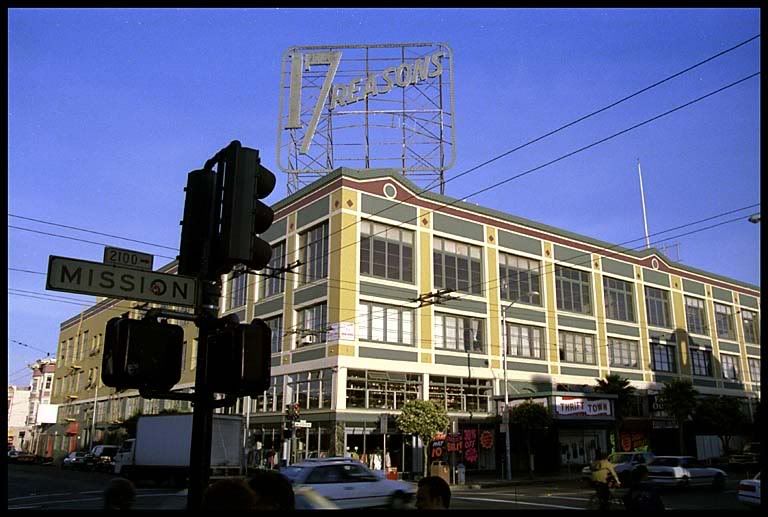
Along with being a curiosity, the sign has been a source of inspiration. It's the name behind a rap compilation called 17 Reasons and a now defunct Noe Valley arts-and-crafts shop also called 17 Reasons. A former San Francisco resident named her band after the sign, even after moving to the Portland area. "I liked the enigma of it. Nobody seems to know what the sign stood for, what 17 Reasons meant," said Sattie Clark, lead singer of the pop-rock band, 17 Reasons Why, which disbanded last year. "People would come up with things, but nobody would give me a reason that satisfied me."
Clark, an Oakland native who lived in SoMa from 1987 to 1990, had been strangely captivated by the sign.
"I would see it every time I got to that intersection - I thought it spoke to me personally," she said. "Nobody seems to look at it. It seemed like it was almost invisible, but it was so big."
Many people have lived or worked in the Mission for years without looking up at the roof of the four-story building at 2101 Mission St. Even if they have noticed it, very few have any idea what it means.
'A piece of art' Alex Orszulak, a self-described "non-dot-commer" who has lived in the Mission for more than 20 years, often wondered what the sign meant, but not often enough to ask.
"It's always been sort of mystical," said Orszulak, 31, who uses the sign as a compass because it is visible from many parts of The City. "You're not supposed to ask why."
Enrique Mendoza used to work in the building next door to the sign but still has no idea now what the 17 reasons are.
"I've noticed it since I lived here," said Mendoza, who moved to the Mission in 1986. "I think it has something to do with soda pop - 7-Up, a drink."
Pleas Braxton, who sweeps the streets for San Francisco's League of UrbanGardeners, said whatever the reason, the sign should stay: "It's a piece of art."
Longtime residents will remember - and this is where the curious will learn much of the mystery - that the sign was a slogan for what was one of the largest furniture stores in The City, the Redlick-Newman Co., later simply Redlicks.
But the sign's history is clouded. For example, some people believe erroneously that the 17 stands for the store's 17 showrooms. And if you ask people why the "Why" fell off, many say it was blown off during fierce wind storms a couple of years ago.
Nothing but the truth
To get the real story, you have to go straight to the source: 86-year-old Charles Redlick, who not only is alive and well in San Mateo, but still going to the gym.
Redlick ran the store from 1945 - when his father Abraham, known as "A.L.," died - until he closed the store's doors in 1975.
What was eventually to become Redlicks was founded by the Redlick brothers, including A.L., on 18th and Mission streets in 1906 to help people refurnish their homes after the earthquake, Charles Redlick explained. The store, later Redlick-Newman, moved to the corner of 17th and Mission after that building was finished, around 1913.
The sign, however, did not appear until the 1930s. Redlick said it was erected by the Occidental Stove Co. and said "Occidental Stoves," a brand of gas ranges Redlicks sold.
Still in the '30s, Redlicks decided to remove the ad in favor of replacing it with a slogan for the store. The partnership with the Newmans, who were related to the Redlicks by marriage, ended due to a feud and the company became known simply as Redlicks.
"We were looking for some message to bridge over the fact we were changing the name," Redlick said.
And the reason?
The 17 Reasons was his father's idea.
"My father developed this slogan after much study, asking everybody and their cousin," he said. "He'd gotten the idea from Heinz 57 years back. They had 57 brands of food or pickles, whatever."
The 17 did refer to the fact the store stood on the corner of 17th Street. But what were the reasons?
"People would ask what the 17 reasons were, and we would guff it off. There were no 17 reasons," he said.
Redlick said he closed the store in 1975 because it was no longer profitable. He said the construction of BART along Mission Street, changes in the neighborhood and the growing popularity of indoor malls contributed to Redlicks' demise.
But the sign, which was visible from many parts of The City, remained lit until the bitter end: "When the business closed, we turned the lights out."
As for why the "Why" fell off, the storm myth is dispelled by the building's manager, Comrado Amador, one of few others who knows anything about the sign.
Amador said he took the "Why" down himself in 1995 because of safety concerns.
Impossible to get rid of
"The pigeons got inside, and it got all rusted," he said. Age as well as the bird droppings were the culprit. "We were afraid the wind would come, and the pieces would fly around and hurt somebody."
Why the 17 Reasons sign, which is now covered in graffiti, continues to stand is hardly sentimental: No one has been able tear it down.
Steve Moore, vice president of Thrift Town's parent company, Norquist Salvage Corp., said the building's previous owner, Alexander M. Maisin, looked into removing the sign but found his options - which involved either a helicopter or welding torches - prohibitively expensive.
"The only reason Maisin was interested in taking it down is because he thought it would fall down," Moore said.
Norquist looked into leasing the sign to a billboard company. The company was in negotiations with San Francisco's Infinity Outdoor Inc., which planned to wrap the sign with vinyl and sell the space for advertising, but that deal fell apart because Infinity wanted various safety improvements made.
Thrift Town has been the building's main tenant since 1979 and now shares it with a smattering of dot-com companies, sewing factories and other small businesses.
Promotion bombed
After Maisin died in 1998, Norquist bought the building to keep it from turning into a Rite Aid. But the Burlington, Vt., company was only able to hang on to it for a year before selling it last year to San Francisco's Adare Properties, retaining a 10-year lease.
When Thrift Town first moved into the building, Moore said he tried to use the sign to promote the opening by offering 17 giveaways to new shoppers. "I tried to make a promotion out of it, but it bombed. Nobody knew what the hell I was talking about," said Moore, who considers the sign a "wasted asset." "I don't think anyone pays any attention to it."
Try telling that to Sattie Clark, who still seems attached to the sign even though her band no longer exists and she lives in a different state.
Clark admits learning the sign advertised a furniture store is a bit of a letdown. But, she explained, her attachment is to the physical sign itself.
"If I had a million dollars, I would buy that sign and restore it," she said. "It has suffered so much, even in past 10 years. Someone needs to declare it a landmark and do something to restore it in the very near future, or it's going to be too late."
BOB MCLEOD, EXAMINER PHOTO
LOAD-DATE: September 18, 2000
